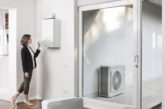
Improving insulation standards in existing homes is important, says Neil Sawers, Commercial Technical Manager at Grant UK.
A core objective of the new Building Regulations is to improve the fabric efficiency of buildings. This is important not only for properties where a low temperature heating system is being installed but for all homes, reducing heat loss can be very beneficial.
Minimising the amount of heat that can escape from a property should be a key focus. Low temperature systems in particular will struggle to perform efficiently if too much heat is being lost so any property considering an air source heat pump needs sufficient insulation levels. Even for homes not currently looking to swap to a low carbon, low temperature heating system, homeowners could enjoy warmer, more efficient homes if they improve their insulation standards.
Improving insulation in existing homes can be done in several ways. Installing loft insulation with a minimum thickness of 270mm is a popular measure that effectively reduces heat loss and is simple to do. Insulating between the roof rafters is an additional measure to consider. Cavity wall insulation or insulating solid walls can improve the fabric efficiency of walls and upgrading windows and doors, to double or triple glazed options, can significantly help rooms retain their heat. Draught proofing existing windows and doors is a simpler measure which also effectively reduces heat loss. It goes without saying that all pipework must be insulated such as that running to and from the heat pump, cylinder, and on tanks and pipework within the loft space. Oh, and get rid of all secondary returns!
A property’s heat loss must be addressed as part of the system design but it may be that some of these measures are installed straightaway and then additional insulation improvements can be made later.
For further information about home insulation measures, please visit Grant UK’s blog: www.grantuk.com/about/blog/getting-your-home-heat-pump-ready













